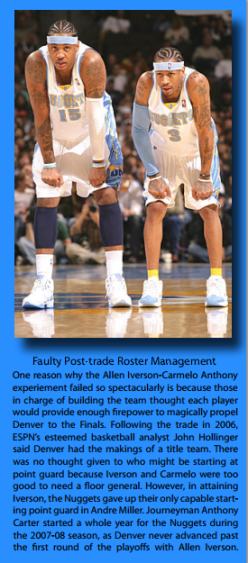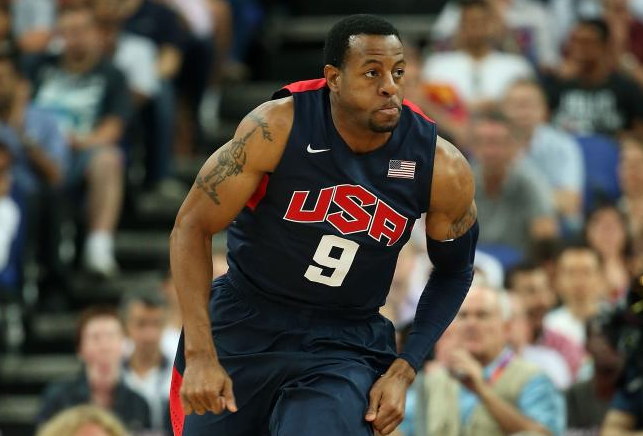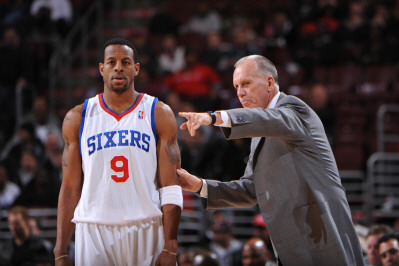The Blueprint: How the Denver Nuggets can reach 50-wins
October 26, 2012 2 Comments
Introduction:
- A player cannot simply replicate his numbers when moving from one team to the next by sliding in place of the starter for whom he’s been traded. Despite numerous projections from the game’s most renowned and well-respected experts, the game of basketball is much too complex for statistically driven forecasts to hold much weight.
- Iguodala’s impact in Denver defensively is going to be drastically reduced because of two factors:
- Doug Collins’ 76ers were the third-best defense in the league last year. Not all of that was due to Iguodala’s presence. Some of it, for sure. But much of it had to do with with Philadelphia’s team philosophy on both sides of the court.
- The 76ers’ roster was built from the inside-out by a coach who seemingly had much more say in the direction of his team than George Karl does in Denver. For example, Collins refused hiring an advanced analytics specialist until this past September when new team General Manager and 22-year veteran Sixers employee, Tony DeLeo, made it known he intended on doing so. In terms of building Philadelphia’s roster before trading for Andrew Bynum, Collins chose Spencer Hawes and one of the most underrated bigs in league history, Elton Brand, as the team’s inside foundation. The reasons for this are many, with the main concern being that if a team can’t rely on its interior, it can’t rely on anything. The Nuggets’ roster as currently constructed, especially following the Nene trade, has for all intents and purposes been built from the outside-in. Lawson is the team’s engine; as Lawson goes, so goes Denver. Their hyper-fluid motion offense dependent on dribble penetration highlights this fact. Furthermore, the Nuggets cannot rely on their interior at either end of the court. Some of this is due to the unorthodox nature of their play (ie. constant fast-break, pressure defense). But a good portion of it is because the two bigs they deem most suitable to playing that style–JaVale McGee and Kenneth Faried–are as fundamentally flawed on the basketball court (particularly defensively) as you can get. A wing defender, no matter his abilities, will not be able to make up for McGee and Faried’s deficiencies inside.
Can this team live up to the lofty expectations members of the national media have bestowed upon it? What players work with Iguodala? How can each individual player actually produce what’s being predicted for them? And will it all add up to over 50-wins?
How the Denver Nuggets can win 50+ games:

To get the requisite production you’re accustomed to from Andre Iguodala you need to surround him with players similar to those that made him so effective — in terms of both skill-set and production. Because if there is one absolute truism it’s that Iggy is not LeBron James. Andre Iguodala can’t go anywhere and win games for you like the King. No one can. Living or dead.
As such, in order to make his transition as seamless as possible, we must cobble out of Denver’s roster–utterly transformed and stripped-down by trades over the last two seasons–different lineup pairings to make the Mile High City’s newest star shine. A player cannot simply replicate his numbers when moving from one team to the next by sliding in place of the starter for whom he’s been traded–especially a starter he’s not similar to in skill set. Expecting that to be the case is the very height of hubris-based ignorance. Too many things go into how a basketball team works. Thankfully, some of us are around to pinpoint potential problems and remedy them before they become a larger, more grave, concern.
When looking at Andre Iguodala’s career-arc we see that as an overall player the last two years were some of his most effective (even though he’s said those years in Philadelphia were among the least enjoyable of his career). In 2011-12, he had the second-lowest turnover rate, second-highest steal-rate, second-highest defensive rebound rate, and the third-highest effective field goal percentage of his career. In the 2010-11 season, Iguodala posted the highest assist rate of his career in conjunction with his second-lowest turnover rate and fourth-lowest usage. What was it about those teams that made him so effective?
The answer is in player, coach and the overarching philosophy surrounding both.
Philadelphia and Doug Collins:
To understand what made Iguodala excel during his last two seasons in Philadelphia, we must first take a look at Doug Collins’ coaching philosophy. Not only is it different from Iggy’s new coach in George Karl, it’s light-years apart.
One thing Collins was devoutly opposed to in Philly was messy, turnover-ridden basketball. It’s why he demanded a slower-pace and half-court setting befitting high-percentage (yes, even those of the mid-range variety) shots that minimized long rebounds leading to run-outs and fast-breaks. It’s the only way he saw a roster of his skill, youth, and talent level reaching optimum success. It was his job, after all, to figure out a way to win the most amount of games he possibly could with what he’d been given. And he hadn’t been given much.
Only five teams took less 3-pointers than the Sixers last season (Pistons, Bobcats, Grizzlies, Jazz, and Hornets). Likewise, Philadelphia turned the ball over a league-low, 10.9%, while playing at the NBA’s seventh-slowest pace. The second-closest team to Philadelphia’s league-lowest turnover rate was Vinny Del Negro’s Los Angeles Clippers, led by the best point guard in the game today, Chris Paul and its elder statesman, Chauncey Billups. The Clippers turned the ball over nearly two full percentage points more (1.8) than Philadelphia. To illustrate this discrepancy, a 1.8% gap between the Clippers and Orlando Magic/Miami Heat is separated by 21 different NBA teams.
Under Collins, the Sixers played a slow-down, methodical, possession-by-endless-possession, grind-it-out, defensive-minded game. Even still, Iguodala turned the ball over 13.6% of the time in Doug Collins’ offense. Arron Afflalo, the player Iguodala is replacing in Denver, turned the ball over just 9.35% of the time in George Karl’s break-neck pace the last two seasons. Some say Afflalo wasn’t as responsible for creating in the same ways as Iguodala. Others posture Afflalo was nothing more than a spot-shooter. These people would be wrong on both counts. Last year, with Afflalo as a primary option in Denver, he put up a 1.4% greater usage rate than Iggy and still turned the ball over 4.3% less.
Statistics in basketball — particularly those of the advanced variety — are having the negative side-effect of divorcing decision-makers from basic, fundamental, sound logic and common sense. Because any person in their right mind would have seen the aforementioned turnover statistic on its own and thought twice about making the trade. George Karl does not advocate winning games using ‘pretty’ basketball. Some of that has to do with the severe lack of talent he’s been given, but most of it has to do with him. Name another coach in the league that would encourage his players to turnover the ball more often rather than less. Messy basketball doesn’t equal winning basketball unless it’s being executed by elite or nearly-elite players (see: 2009 Denver Nuggets).
Team-building, the Denver Nuggets, and Pace:
One major mistake many general managers and team executives make in building their team is architecting it around a single over-arching philosophy. George Karl likes to get out and run in Denver’s altitude. Therefore, his front office has built around that run-and-gun dictum by signing a multitude of athletes to execute it.
There are a number of different problems you encounter when building a team through a philosophy-first approach like Denver is doing now. First, you prove yourselves to be gainfully incapable in a half-court setting unless your players are incredibly skilled and focused on sound fundamentals and consistency at both ends of the floor. Sound fundamentals and defensive consistency do not come naturally to a team as laden with youth as Denver. Those sorts of things develop over time, which is why the best ways of building a team combine youth and veteran alike (see: San Antonio, Oklahoma City, Memphis, Miami, Brooklyn, Boston). Secondly, when a team emphasizes pace over everything else in the way George Karl does, any and all fundamentals go right out the window because players are too focused on moving and not focused enough on detail.
Combine Denver’s lack of familiarity between teammates with their youth and George Karl’s laissez-faire run-and-gun philosophy and you have the makings of a disaster. Some might disagree and point me towards Oklahoma City and the success Scottie Brooks (who learned under Karl) is having with their high-paced and open offense. The problem with that argument is its outright refusal in recognizing the disparity in talent between the Thunder and Nuggets. Ty Lawson, Danilo Gallinari, Andre Iguodala, and Kenneth Faried do not in any universe equate to Russell Westbrook, Kevin Durant, James Harden, and Serge Ibaka — especially offensively. Serge Ibaka is draining 3-pointers from the wing this preseason. Kenneth Faried has a hard enough time holding onto the ball.
Oklahoma City is the benchmark. Sam Presti’s shrewd drafting has earned them that right. Everyone else is just pretending, with Denver captaining the ship. Outside of Kenneth Faried in 2011, the Nuggets haven’t drafted a starting capable player since Kiki Vandegwhe took Jameer Nelson in 2004. The fact Faried is undersized, can’t shoot, lacks a post-game, can’t defend, and is a below-average passer and catcher on top of it all, may require an asterisk besides the Manimal’s name in Denver’s draft history.
This is why it is imperative for teams desiring success to dispatch of this philosophy-first way of thinking. Draft the best players available so that you are able trade them for players who may end up being a better fit within your overarching philosophy later. If a franchise builds from within a half-court mindset first, they set themselves up for success beyond just the regular season. As the Spurs have so effectively illustrated over the last couple of years in transitioning to a more offensive-minded game plan, everyone can run. Half-court players can run just as much as athletes. It’s the level of execution that make the difference.
Tomorrow, I lay out the blueprint for Denver’s 50-win season. And I don’t even advocate for someone’s firing. Thanks for reading.







You must be logged in to post a comment.